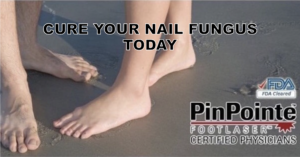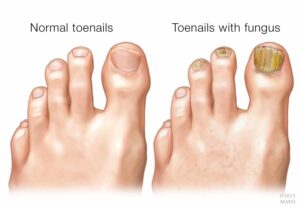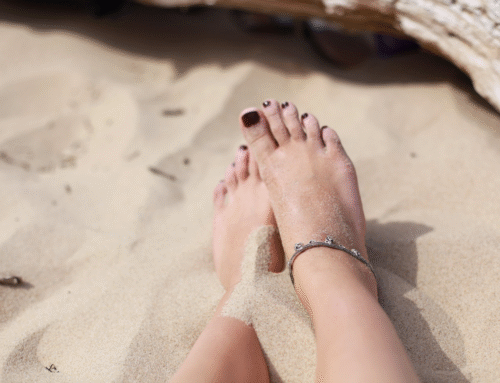Scaly toenails and toenail fungus can go hand in hand. If you are experiencing scaly toenails, it could be a toenail fungus infection that is developing. It is important to keep good foot hygiene to prevent the infection from spreading to your other toenails or fingernails.
What causes toenail fungus?
Toenail fungus develops when microscopic fungal organisms infect the nail and the skin beneath it. These fungi thrive in warm, moist environments like inside shoes, locker rooms, or around public pools.
Once an infection begins, you may notice symptoms such as:
- Thick, brittle, or crumbling nails
- Yellow or brown discoloration
- Nail separation from the nail bed
- A foul odor or discomfort when walking
Toenail Fungus Symptoms
Toenail fungus, medically known as onychomycosis, often develops gradually and can be easy to overlook in its early stages. One of the first noticeable symptoms is a change in the nail’s appearance. Typically, it begins with a small white, yellow, or brown spot beneath the tip of the nail. As the infection progresses, the discoloration spreads. The nail may become thicker, dull, or brittle, losing its natural shine. The edges of the nail often become ragged or crumbly. In some cases, the nail may start to lift away from the nail bed—a condition known as onycholysis. Patients may also notice an unpleasant odor coming from the affected nail due to fungal buildup and debris trapped beneath it.
As the infection worsens, toenail fungus can cause discomfort or pain, especially when wearing tight shoes or walking. The nail may become distorted in shape, making it difficult to trim. In severe cases, it can even separate completely from the nail bed. The surrounding skin may appear inflamed, scaly, or itchy, particularly if the fungus spreads beyond the nail area. Multiple toenails can be affected at once, and because the condition is contagious, it can spread to other nails. It spreads through shared nail tools, shoes, or floors in communal areas like gyms or pools. Without treatment, the infection can persist for years, leading to ongoing discomfort and cosmetic concerns. Recognizing these symptoms early and seeking proper medical care can help prevent progression and improve treatment success.

Scaly Toenails
Scaly toenails are a common sign of underlying toenail problems, especially fungal infections. When the toenail becomes dry and brittle, it often starts to flake or peel. This scaly appearance can make the toenail look unhealthy and uneven. Many people mistake it for simple dryness, but it usually indicates something deeper.
Toenail fungus is one of the most frequent causes of scaly nails. Fungus grows in warm and moist environments, making toes an easy target. As the infection progresses, the toenail may thicken, change color, or lift from the nail bed. Early treatment is important because fungal infections rarely improve on their own. Addressing the problem quickly can help restore the toenail’s normal appearance.
How is it different from other toenail conditions?
Not all toenail changes are due to fungus. Here are some key differences to help you tell them apart:
- Nail injury vs. nail fungus: If you injured your toenail (stubbed your toe or dropped something on it), you might see a black, blue, or red bruise under the nail. This trauma mark usually doesn’t smell and will not spread to other nails. Over time, the bruise grows out as the nail grows.
- Nail psoriasis vs. fungus: Nail psoriasis (an autoimmune condition) can look a lot like fungus, but there are clues. Nail psoriasis symptoms often display themselves as tiny pits (little dents) on the surface and sometimes reddish-brown patches under the nail. Also, psoriasis usually appears on fingernails alongside other skin symptoms (like scaly patches on elbows or knees).
- Other infections or conditions: Certain problems, like bacterial infection or nutritional deficiencies, can affect nails; however, they also have distinguishing signs. For example, if your nails are unusually soft or peeling but without discoloration, it might just be due to dry nails or chemical damage. Athlete’s foot (a type of skin fungus between toes) is commonly linked to toenail fungus. If you have a bad case of athlete’s foot along with nail changes, that’s a strong hint that the nail issues are fungal. Always consider the overall picture: fungal nails often come with a history of foot fungus, while other nail problems usually have a specific cause (injury, eczema, etc.).
Treatment with Laser Nail Therapy
The PinPointe FootLaser offers several appealing benefits for individuals struggling with toenail fungus, medically known as onychomycosis, particularly those seeking a noninvasive, drug-free treatment option. One of its primary advantages is that it targets the fungus directly beneath the nail without the need for oral medications, which can sometimes cause liver-related side effects or interact with other prescriptions.
The laser energy penetrates through the nail plate to heat and weaken the fungal cells. This allows the body’s natural processes to promote healthy nail growth. The procedure is quick—typically lasting around 30 minutes per session—and requires no anesthesia or downtime. This allows patients to resume normal activities immediately afterward. For many, this makes it a convenient and safe alternative to long courses of antifungal pills or topical creams that may take months to show visible results.
We offer free consultations
We offer free consultations to see if laser treatment is right for you. At our clinic, laser nail therapy with the PinPointe Footlaser is our specialty. We focus on this treatment because it offers a safe, effective, and medication-free solution for stubborn toenail fungus. We understand how frustrating it can be to deal with thick, discolored nails and how overwhelming it is to sort through different treatment options.
During this consultation, our foot doctors will evaluate your nails, discuss your health history, and determine whether laser treatment is the best choice. During your consultation, we will:
- Examine your nails to confirm the diagnosis and assess severity.
- Explain exactly how the PinPointe FootLaser works and what you can expect during and after treatment.
- Give you a realistic timeline for seeing clearer, healthier nails.
- Answer any questions you have about nail care and preventing reinfection.
Our goal is to help you confidently move forward with a treatment plan that finally addresses your toenail fungus safely and effectively, without the side effects or drug interactions of oral medications.






